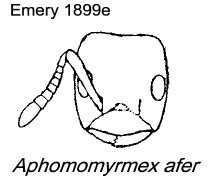Aphomomyrmex afer Emery
  Type location Cameroun (Aphomomyrmex afer n. sp., Emery,
1899e: 494, all stages, illustrated) collected by Conradt and L. von
Muralt Type location Cameroun (Aphomomyrmex afer n. sp., Emery,
1899e: 494, all stages, illustrated) collected by Conradt and L. von
Muralt
Junior synonym muralti (Aphomomyrmex
Muralti n. sp.,Forel,
1910e: 449, worker only; synonymy by Snelling, 1979b) from South
Africa, Natal, Dr L von Muralt.
A specimen is pictured by Hölldobler & Wilson (1990, page
133); all forms known. ; see Bolton, 1995)  . .
|
  Emery's
(1899e) description is at Emery's
(1899e) description is at  and for the sexual stages at and for the sexual stages at  . Forel's (1910e) description of muralti
is at . Forel's (1910e) description of muralti
is at  . Arnold (1920a) gave a translation of the
descriptions by Emery (1899e) and Forel (1910e) for muralti -
this is at . Arnold (1920a) gave a translation of the
descriptions by Emery (1899e) and Forel (1910e) for muralti -
this is at  . .
Essentially - the colour is black, with appendages rusty
red, the scape paler; generally very shining and smooth, finely
puncturate on the sides of the head, thorax and gaster. Fine greyish
pubescence on thorax and gaster; also a few pilous hairs.
Head subquadrate, a little narrower in front, posterior angles rounded,
the eyes placed in the middle of the sides, with three ocelli forming a
large triangle.
|
 WORKER
- HL 0.605-0.992 mm, HW 0.348-0.547; SL 0.333-0.531 - these
ranges, as determined in a specific study by Meunier et al.
(1999), together with their observation that the overall morphology was
constant across the size range, do not support the description by
Snelling (1979b) of the species as being "polymorphic". Mandible with
5-6 teeth on apical margin, basal tooth greatly offset. Median lobe of
clypeus, broader than long, moderately convex longitudinally and
transversely; apical margin projecting slightly. Antennal scape not
reaching occipital margin. Occipital margin broadly and weakly concave;
concavity most pronounced in smallest workers. Alitrunk wider than
long; convex in profile, with abrupt descent into metanotal groove.
Propodeum broader than long, sides gently convex; declivity flat in
profile, twice as long as dorsum; spiracle large. Petiole node a scale.
Acidopore with conspicuous long fringe. WORKER
- HL 0.605-0.992 mm, HW 0.348-0.547; SL 0.333-0.531 - these
ranges, as determined in a specific study by Meunier et al.
(1999), together with their observation that the overall morphology was
constant across the size range, do not support the description by
Snelling (1979b) of the species as being "polymorphic". Mandible with
5-6 teeth on apical margin, basal tooth greatly offset. Median lobe of
clypeus, broader than long, moderately convex longitudinally and
transversely; apical margin projecting slightly. Antennal scape not
reaching occipital margin. Occipital margin broadly and weakly concave;
concavity most pronounced in smallest workers. Alitrunk wider than
long; convex in profile, with abrupt descent into metanotal groove.
Propodeum broader than long, sides gently convex; declivity flat in
profile, twice as long as dorsum; spiracle large. Petiole node a scale.
Acidopore with conspicuous long fringe.
The photomontage is collated and slightly enhanced from
the Antweb.org site at http://www.antweb.org/specimen.do?name=casent0101212
Collection Information: Specimen Code CASENT0101212; Locality Cameroon:
[Ndian Dist:. The Rack, Korup For. Res.; D. McKay, coll, Ex Leonardoxa
africana]; Collection codes: ANTC3231; Date: 8 Feb 1979; Collected
by: D. McKey
Closely related to Petalomyrmex
phylax, the only other African member of the Tribe. Both ant
species are inhabitants of subspecies of the forest understorey tree Leonardoxa
africana and have been extensively studied by Doyle McKey and
colleagues - see McKey studies for
details and reference list. In Cameroun, A. afer primarily
occupies the L. africana subspecies letouzeyi (ssp L3
or T3 in earlier papers), but it also has been found, albeit much more
rarely, in hollow twigs of another myrmecophyte Vitex grandifolia.
In L. africana letouzeyi, A. afer tends homopterans
inside the domatia (specialised "ant cavities"). The homopterans have
been identified as a coccid, Houardia abdita, and/or a
pseudococcid, Paraputo anomla.
The subspecies letouzeyi McKey (2000) of L.
africana is described as occurring in the wettest forests of
Africa, the lowland forests near the Bight of Biafra, running east from
Uwet Division in Calabar Province, Nigeria, across the border into
western Cameroun, essentially in the dark understorey of wet, cloudy
forest.
In his catalogue, Wheeler (1922) listed both species afer
and muralti; citing also Arnold (1920a). To me, the highly
specialised life style suggests that afer from Cameroun and muralti
from Natal, South Africa, are indeed separate species but, as yet I
know too little of the distribution of Vitex grandifolia.
Snelling (1979b) considered the question of muralti, examining
the type and two specimens Forel had seen from Cameroun. Snelling also
examined females from various localities and decided that muralti
was not significantly different from afer. The Forel specimens
from Cameroun had been collected by van Muralt and although noticeably
hairy, punctate and larger, were more logically afer. Snelling
also noticed that the holotype specimen of "muralti" had "Natal
(v. Muralt)" on the identification label but in a different hand to the
identification. Snelling thought it conceivable that the "Natal" was an
error. As my name index shows, L. von Muralt's name was given to Crematogaster
muralti and Tetramorium muralti - both were collected in
Cameroun and both were first described by Forel (1910e, and 1910d,
respectively). Snelling listed seeing specimens from Cameroun - the
Conradt and Von Muralt collections; plus a modern collection - at
Nkoe-Mvone, by C. Collingwood, 5.ix.1968; from Gabon, I. Lieberburg,
x.1972; Zaire, Ross & Leech, at 50 km s of Tahela, and 24 m N.E. of
Lubefu. Outside of West Africa and the Congo Basin, the sole specimen
was the mysterious Natal example. As I have not seen any mention of
von Muralt other than Cameroun, I agree with Snelling that the "Natal"
label is simply wrong. |